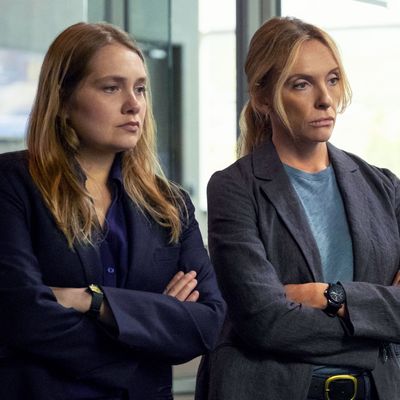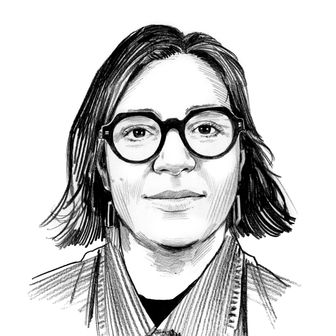
If all you know about Unbelievable is that it follows a pair of maverick cops as they try to catch a serial rapist, you might assume it’s just another true-crime story depicting violence against women. You’d be mistaken. The Netflix drama is less interested in the rapist and his horrific crimes than in another, more insidious villain: the criminal-justice system.
Over eight tightly constructed episodes, Unbelievable illuminates how police and prosecutors, who tend to be men, routinely disregard and disbelieve the accounts of women who’ve been raped. Based on the story of an actual investigation in Colorado and Washington that was first chronicled in a Pulitzer-winning ProPublica article, it tells the tale of a male cop who botched a rape investigation, and a tenacious pair of female cops (played by Merritt Wever and Toni Collette) who, bucking the system, seek justice for a series of victims. (Kaitlyn Dever is particularly affecting as a teenager who is charged with false reporting after telling the cops about her attack.) This may sound like difficult viewing, but the show is every bit as as riveting as the most gripping thrillers — a testament to the skill of the writers, who include Michael Chabon and Ayelet Waldman, and the showrunner, Susannah Grant, who wrote the screenplay for Erin Brockovich. Recently, Vulture caught up with Grant to talk about how she turned this heavy material into such propulsive and essential TV.
I was struck by the way you shot the rape scenes. They seemed very different from most depictions of rape I’ve seen in TV or film, in part because they’re never remotely titillating. You’re always shooting from the victim’s perspective. How did you approach these scenes?
I had never a written a scene of sexual violence before. When I sat down to write it, I wanted to make sure that we weren’t doing anything that could, in any way, evoke rape porn, of which there is already way too much in our culture. It was clear I needed to write it from a subjective viewpoint, with very selective images, and that the images should be the memories that Marie [played by Dever] herself is carrying and wrestling with.
You also dedicate little time to showing the perpetrator onscreen or delving into his psyche. Was there much discussion about how much space he should take up?
Really early on, we said, This isn’t a story about him. I didn’t want viewers to meet him until the detectives met him.
Why was that?
Because we wanted to tell the story of these three women. We were telling two stories: the story of one woman who has experienced the worst possible kind of repercussions after reporting a rape, feeling like she was completely alone in the world, and these two other women, hundreds of miles away, who, without knowing it, are busting their asses to save her.
Did you think of it as a consciously feminist project?
Um, no. [Laughs.] I mean, I didn’t not think of it as a feminist project. It wasn’t something I thought about. I didn’t sit down to write a feminist piece. I sat down to write something good and make something good. But maybe, just as a feminist, anything I write is a feminist project.
The way you talk about shooting the rape scenes, that seems like a very specific choice that’s in contrast to the ways that rape scenes have often been shot in the history of TV and cinema.
I had this really vivid reaction when I watched The Jagged Edge in 1985. I hope I’m remembering this right, but my memory is that the rapist cuts off the nipple of his victim. I remember sitting there going, You disgusting fucker. It was so disgustingly, weirdly, horribly titillating, and I was just like, I’m never doing that shit. I don’t really want to slam [Jagged Edge director] Joe Eszterhas, because it’s hard to make a good thing and I thought he made good movies. But that one scene, I said, The world has enough rape in movies. But it turns out it doesn’t.
Why do you think you changed your mind on that?
I was just starting my journey as a writer. It shows you that the bold declarative statements you make when you’re starting out in your career … [trails off and pauses] obviously, there’s always a new way of doing something. If you’re doing it with integrity, it’s worth doing.
What was the most important thing you learned about how rape is investigated, and how that process should be changed?
Experience matters and training matters. The experience and training that those detectives had in Colorado was so different from the experience and training of the detectives in Washington. The guy who investigated Marie’s case had just transferred over from narcotics. It was either his second or third sexual assault he’d investigated. He didn’t have a career of interviewing women who had been through this experience. He didn’t have the understanding that those cops in Colorado had.
It was interesting how the viewer doesn’t necessarily realize how bad the first cop is at his job until we meet the cop who will eventually go on to solve it. We get to see how differently she approaches her own investigation.
I thought about this a lot. A simple villain who is motivated by nothing other than malice is not nearly as interesting as someone who thinks he’s doing all the right things and makes absolutely cataclysmic mistakes in what he thinks is in the name of justice.
But I was also thinking broadly about the issue of our cultural collective mistrust of rape victims. It’s a crime in which the victims are routinely disbelieved, you know? Nobody says to a carjacking victim, “I don’t think it really happened.” When something is that widespread, it can’t just be because of a few bad actors. We, as a culture, have absorbed some essentially bad information in a way that we’re not aware of. I wanted the audience to be able to understand how this cop would make these bad decisions, because I liked the idea of making the audience complicit in those bad decisions.
As disturbing as the show is, it’s so entertaining too. How did you balance those forces?
A really propulsive storytelling engine — these two detectives actively investigating someone that we, as viewers, really want caught — buys you room to introduce character, to introduce relationships, to introduce the fact that investigating a horrible crime doesn’t mean that every minute is horror. There are moments of levity. That’s just my storytelling instinct. I don’t live in a world of bleakness, myself. I hope I’m willing to look unflinchingly at really bleak things, but I also really hold to the belief that the depths to which you’re able to experience stress and pain are equal to the heights to which you’re able to experience joy.
The cops played by Wever and Collette are so funny and entertaining and warm. Those characteristics are maybe alluded to in ProPublica’s article, but we don’t really see them in action. How did you develop their storylines?
I took a lot of creative license. We changed all the names of all the characters in the show, primarily out of respect for the privacy of the people involved. For those two characters, I use some of the facts of their lives as inspiration — and the qualities that their work suggests — but I don’t know anything about their personal lives or their marriages, nor did the women want that to inform our telling of it. At the same time, you’re not gonna tell a story and not know the fullness of the two main characters’ lives. So I took a lot of creative license there, and then we hired Toni and Merritt, who add so much texture to any character on the page. They’re both so full of surprises.
Did you worry about how difficult Marie’s story would be to watch? How opening with her, as opposed to opening with the cops and the suspense of their unfolding investigation, might lose viewers?
I didn’t worry about it, because I knew this was a real person’s experience. It felt like we would’ve been misrepresenting something that was essential to not misrepresent, you know? I didn’t want to try to soft-pedal it.
People often will say, and it’s true, that the rape investigation feels like a second assault. And there are a lot of difficult images in that first episode. But we had a screening for a small group in New York, and the thing that had the audience gasping audibly was when Marie was asked to tell her story again, for the fifth time that day, only write it down this time. I wasn’t worried because I think you’re drawn towards this young woman. I think audiences can handle that. It also helps knowing that all eight episodes are going to drop at once, and that people can roll right into the next episode.
Do you watch any other true-crime shows? Were there any you drew inspiration from?
I didn’t look to other shows for inspiration. You do have to keep in mind, these are real people and you have to treat their stories with respect, which doesn’t mean you have to be just flatly flattering to everyone. You don’t, but you do have to respect the truth of what they went through.
There’s so much texture and detail about life inside the force and how investigations actually function. Did you have a cop consultants?
We had a great cop consultant named Liz Devine who worked with CSI for a long time. She had worked in the sheriff’s department in L.A. She had a lot of hands-on experience, but also theatrical experience, so she was there any day that law enforcement stuff was in play. We really gave her authority to tell us when we were doing something that wasn’t accurate.
There was one line in the ProPublica article that I was struck by, where Stacy Galbrith, the detective who inspired Merritt Weaver’s character, says, “A lot of times people say, Believe your victim. But I don’t think that’s right. I think it’s, Listen to your victim.” It made me curious to hear how you thought about this story in light of #MeToo.
We sold it right before the revelations about Harvey Weinstein kicked off a massive movement. We had a meeting with our host at Netflix, and they wanted to talk about whether or not the movement affects this storytelling at all. Were there any adjustments we wanted to make, given what the world has become and what our culture has become? We all decided, No, let’s just tell the story we’re going to tell and see where it lands.


